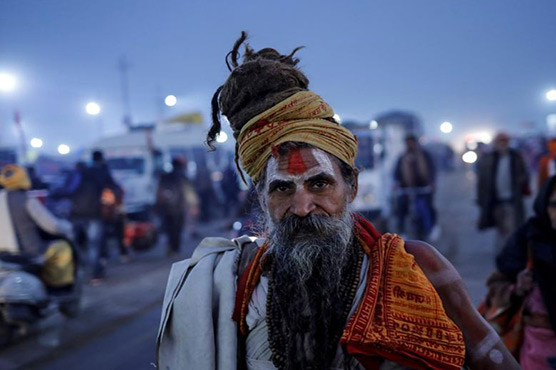Millions expected to throng Indian city for world's largest religious festival

A 'Sadhu' walks on a road at the "Kumbh Mela", in Prayagraj, India, January 13, 2019.
PRAYAGRAJ, India (Reuters) - Pilgrims from across the world are gathering in India for the Kumbh Mela, a heady mix of spirituality, politics and tourism that begins on Tuesday, garnering extra attention ahead of a general election in the Hindu-majority country this year.
During the eight-week festival at Prayagraj in the northern state of Uttar Pradesh, authorities expect up to 150 million people, including a million foreign visitors, to bathe at the confluence of the Ganges, the Yamuna, and a mythical third river, the Saraswati.
Devout Hindus believe that bathing in the waters of the Ganges absolves people of sins and bathing at the time of the Kumbh Mela, or the “festival of the pot”, brings salvation from the cycle of life and death.
“Belief is what brings us here, to bathe in the waters despite the cold,” said Ram Krishna Dwivedi, making his way back from the shore dressed in flowing white robes.
More than 80 percent of India’s 1.3 billion people are Hindus, many of them deeply religious despite an increasingly Westernized middle class.
On Tuesday, millions of pilgrims, led by naked, ash-smeared ascetics, some of whom live in caves, will plunge themselves into the cold waters during the first Shahi Snan, or Royal Bath, that begins at around 4 a.m. (2230 GMT).
With less than 24 hours until the festival starts, the last of the arriving ascetics paraded towards temporary ashrams, or monasteries, built of corrugated iron and canvas, many bedecked with fairy lights, on the east bank of the Ganges.
Pilgrims poured in to the site, which is closed to traffic around bathing days, carrying bundles on their heads, while vendors peddled balloons and candy floss, as security men stood guard, with priests and police seated side-by-side.
Authorities have set up temporary bridges, 600 mass kitchens and more than 100,000 portable toilets in a pop-up city at the confluence of the rivers, which is known as the sangam.
Those with cash can stay at luxury campsites on the river banks that offer ayurvedic spas and yoga, and cost up to 32,000 rupees ($455) a night.
Most pilgrims make do with more modest lodgings, sleeping in big communal tents or out in the open.
“I don’t know where I will stay yet, but you do not often get to meet these saints and sadhus,” said Rajendra Singh, a retired soldier and now a security guard, who came by bus from the state capital, Lucknow, about 200 km (124 miles) away.
On Monday, a small fire broke out at one of the camps, though there was no report of any casualty, according to Reuters partner ANI. Authorities later warned pilgrims about open fires.
POLITICAL PILGRIMAGE
This year’s event comes at a critical time for Modi’s Hindu nationalist Bharatiya Janata Party (BJP), expected to face a tough contest in a general election due by May.
It lost power in three key states in assembly elections in December, and will want to avoid a similar result during the general election in Uttar Pradesh, a state of 220 million where a good showing can often decide the outcome.
The state’s chief minister, Yogi Adityanath, is a firebrand Hindu priest from the BJP, who has championed policies that play to the party’s core Hindu base.
This year Adityanath has transformed a smaller Ardh, or “half” Kumbh Mela, into a full version of the festival.
He has also lobbied to build a Hindu temple on the site of a former mosque, and renamed several cities with Hindu names - including Prayagraj, which was Allahabad until October.
Modi and his rival, opposition Congress leader Rahul Gandhi, are both expected to attend the festival before it wraps up in March.


